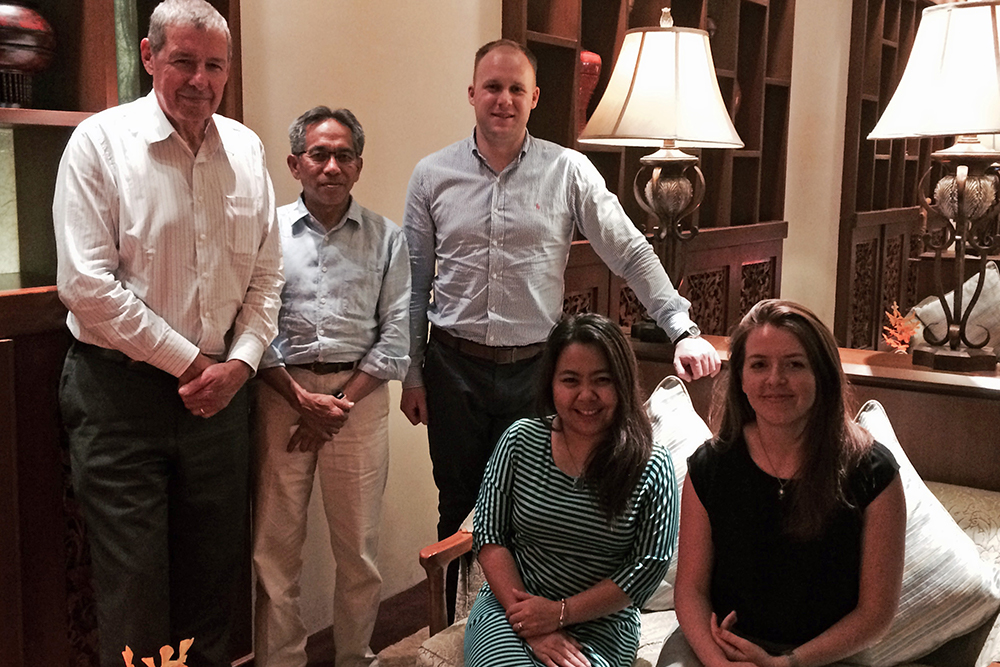
Standing (left to right): John Luxton, Farib Sos and Richard Evans. Seated: Kyaw Hsu Mon and Fiona Natusch
As a member of the Asia New Zealand Foundation’s Leadership Network, I was fortunate to be included in a recent Track II delegation to Myanmar - a country undergoing challenging, delicate and yet remarkable change.
Track II diplomacy is an unofficial form of engagement between countries, typically with think tanks and institutes of strategic studies. In our case, we met with the Myanmar Institute of Strategic and International Studies in Yangon.
Central to all our discussions was the remarkable political reform Myanmar has undergone in the years since 2008, when a new constitution was approved by popular referendum. Despite initial scepticism regarding the result and military’s underlying motives, Myanmar went on to elect a nominally civilian government, remove restrictions on the press and release political prisoners - Aung San Suu Kyi foremost among them. These developments have both surprised and encouraged the international community, with the country gradually shedding its status as an isolationist pariah.
2015 is an especially significant year for reform in Myanmar. First, the Government intends to conclude a national ceasefire agreement with sixteen armed ethnic groups, ending decades of often violent conflict, mostly in Myanmar’s border regions. Second, the legislature has just recently rejected proposals to amend the 2008 constitution - specifically, to devolve power to states and ethnic groups, to end of the military’s 25 per cent voting bloc in the national legislature, and to remove a provision that disqualifies Aung San Suu Kyi from the office of President.
The third and most pivotal challenge is the general election scheduled for November. No one we spoke to expects a clear result. While Aung San Suu Kyi’s NLD enjoys broad support, so too does the Union Solidarity and Development Party (USDP) - successor to the civilian face of the former junta. For many, the ideal outcome would be a USDP-NLD coalition. Supposedly this would provide stability, continuity of reform, and at least a degree of democratic legitimacy.
Also on the agenda was Myanmar’s economic development. Decades of isolation, mismanagement and the “Burmese Way to Socialism” have left Myanmar impoverished. In terms of the Human Development Index, the country ranks lower than any other Asian country except Afghanistan. In GDP terms, Myanmar’s output of $4,700 per capita compares with Sudan and Pakistan. These statistics are particularly tragic when contrasted with a country once the second wealthiest in South-East Asia, and regarded as having better prospects post-independence than any other in the region.
There is great optimism that this potential can be recaptured. In response to the reforms outlined above, the United States and European Union have lifted sanctions and boosted aid and development programmes. The economy is gradually being exposed to foreign investment and, with Aung San Suu Kyi’s blessing, visitors are flooding into a country previously considered an unethical destination. In just five years, mobile networks and ATMs have emerged from nowhere to become ubiquitous.
While Myanmar can achieve a number of quick wins, some challenges will require decades of persistent reform.
Myanmar’s development potential is severely limited by the population’s lack of education and skills. This largely reflects the disintegration and neglect of public education under military rule. Those who manage to access primary and secondary education face rote-learning, poorly-trained teachers and high out-of-school tuition fees (essential for passing exams). Many young people aren’t in the education system at all, with Myanmar ranking among the worst for prevalence of child labour. At the tertiary level, universities were regarded as threats to the regime’s stability and, prior to the 2000s, frequently closed down upon any suspicion of protest activity - sometimes temporarily, sometimes indefinitely, and sometimes reopening to teach by correspondence only.
Improving the education system and retrofitting the working-age population are important prerequisites, both for continued reform and participation in the global economy.
Nevertheless, diplomats and business people referred to a streak of entrepreneurial zeal and industriousness which, rather than dying out, has merely been in hibernation.
Another reason for optimism is Myanmar’s location in Asia. The country is a member of ASEAN, and has immediate neighbours with a combined population approaching 3 billion people - including both China and India. Yet attempts at regional integration come with challenges. While China’s “One Belt, One Road” agenda has bought oil and gas pipelines and hydro-electric projects, some of these have been shut down by protest and local conflict.
We also encountered concern that ASEAN proposals such as the ASEAN Economic Community could wipe out sectors of Myanmar’s economy which, if given more time, could become competitive - such as textile manufacturing, wholesaling and retail. Interestingly, there’s no strong sense of where Myanmar’s future development opportunities lie, and of how it could complement and compete with other regional economies.
This is just one respect in which Myanmar will remain a country to watch for some time.


